Boomsday won’t be the first time Dr. Boom and mechs make an appearance in Hearthstone: they were some of the cornerstones of the game’s first major expansion as well back in December 2014 as part of Goblins versus Gnomes, a set that brought us infamous minions like Piloted Shredder, glorious spells like Tinker's Sharpsword Oil and enough salt to fill the Khewra Mine.
Get the Dead Out of Here
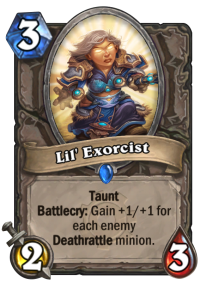
Before the GvG meta could even kick off in earnest, Undertaker had to be nerfed into oblivion. Two cards were introduced in the set that were meant to combat the Deathrattle-synergistic strategies, but unfortunately neither were good enough to stop the onslaught of the undead. Lil' Exorcist was never going to outgrow an Undertaker and Scarlet Purifier wasn’t very effective against cards like Haunted Creeper or Nerubian Egg – so much so that one of the lesser-known Paladin decks in the BRM meta actually used them alongside the latter to pop them in a proactive manner.
The card was eventually nerfed after an extremely long and oppressive reign – we were already two months into the GvG meta when the card finally got obliterated, opening the door for some other strategies that didn’t exclusively rely on minions with the skulls and crossbones on the bottom of their portrait.
Raising the Stakes
For those of us who got used to the almost chess-like back-and-forth of the Classic era, the spike in variance and tempo was a rude awakening in the new set. All previous Arena drafting guidelines had to be thrown out of the window, opting for as many two-drops as possible instead of trying to eek out some more value with just one extra Flamestrike or Polymorph. In Constructed, the stickiness of Piloted Shredder would change the way the game was played all the way until the introduction of Standard, and cards like Unstable Portal or Imp-losion would decide a bucketload of games in these dark times.
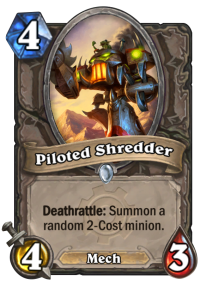
Similarly, Dr. Boom himself was a meta-warping card, single-handedly making Big Game Hunter a meta staple (to the extent that the plucky dwarf even picked up a nerf while the purveyor of Boom Bots got away unscathed), providing both a lot of stats for seven mana and a high-variance clear option with the bots. Two to eight damage overall, distributed to random minions: whatever you may have thought of the original version of Yogg-Saron, Hope's End, at least he didn’t come down on turn seven. While Dr. Boom was a sleeper of the set – famously, the community was salivating over Troggzor the Earthinator, a card that never saw play. Boom remained a part of almost every deck until its eventual rotation. Seeing a trend here?
You Get a Car(d), You Get a Car(d)…
Say what you will about the set’s aggro toolkit though, it must be admitted that control decks have also received a plethora of excellent options. Priest’s ever-present AoE issue was fixed with Lightbomb, Warrior picked up the excellent Shieldmaiden, Warlock got Mal'Ganis for Demonlock shenanigans with Voidcaller (oh how weak and situational that card looks today!), and Antique Healbot gave all classes a very powerful neutral heal option that achieved more in terms of allowing control options than anything else printed to date. Duplicating either this bad boy or a Sludge Belcher made every Control Mage player a happy camper.
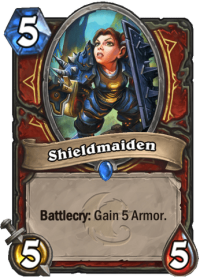
These were quite powerful tools indeed, but it’s not like they lacked worthy opposition: Paladin’s Shielded Minibot and Muster for Battle saw the class drift away from the full-control gameplan into something more midrange-ish, the prototype of the Secret Paladin archetype that would terrorize the ladder later on in The Grand Tournament. Shaman’s Whirling Zap-o-matic and Powermace formed a powerful core of a burn-heavy deck with Mech synergies alongside Crackle while Hunters were using Glaivezooka to devastating effect in aggressive builds. Oh, and Druids still had access to their infamous Force of Nature–Savage Roar combo, the original iteration of which provided 14 damage from hand without any other tool. As fast as today’s Druid decks are at ramping, I’d hazard a guess that they would be long dead before they could pull off their shenanigans if they had to go up against the aggro decks of those days.
The Rise of the Netdeckers
Beyond mechs, the GvG meta was also characterized by the rapid refinement of decklists on ladder fueled by the inception of Tempo/Storm’s meta snapshot. Tierlists and community discussions have existed before as well, but a well-curated and regularly updated cross-section of the metagame and its prevalent archetypes hasn’t existed before, and it provided easy access to ladder-ready and polished decklists for the wider playerbase. The original snapshots are hard to find and are certainly quite raw compared to the kind of content we’re used to today in a space where Vicious Syndicate and HSReplay provide useful alternatives, but they essentially your go-to source of world-class decks at the time.
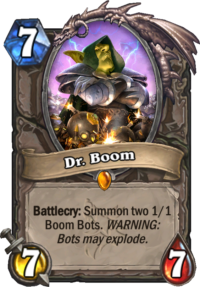
January 9, 2015 marked the end of an era: from that point on, all your opponents were filthy netdeckers and you were rowing upstream in your canoe of creativity.
The first tierlist featured Control Warrior, Handlock, Zoo, Midrange Hunter and Midrange Paladin (initially called Control but renamed by the second edition) on the top, with decks like Face Hunter, Mech Mage, Tempo Rogue, Midrange Druid and Midrange Shaman rounding out the second rung of the ladder. Unfortunately, the decklists themselves have been lost as they were merely provided via imgur links that only return a 404 error now. By week 3, they would be published via the site’s dedicated deckbuilder, meaning they are still available today (albeit showing the nerfed versions of the cards) for those who are interested in such a trip down memory lane. My goodness, how did it take us this long to figure out that running two copies of the FoN-Roar combo is a good thing?!
Science it up
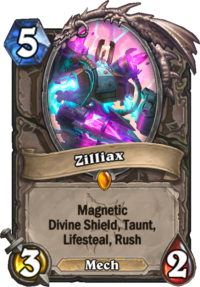
One has to wonder how many similarities there will be between The Boomsday Project and Goblins vs. Gnomes beyond its themes. Looking back, it’s fairly clear that GvG had overshot the mark in quite a few cases with regards to power levels, and while some of the culprits have never been nerfed, later cards are tacit admissions of Team 5’s mistakes by themselves. Imp-losion proudly remains in its original form, but Feeding Time costs one more mana even with a normalized outcome and the removal of the Demon synergy. Similarly, Shielded Minibot’s almost guaranteed two-for-one capability doesn’t come for free anymore on Cathedral Gargoyle and a card like Antique Healbot has been a no-no for a very long time now.
The Magnetic mechanic seems to double down on the tempo origins of the Mech tribe (with Mechwarper playing a major part in the early GvG days) and the Project cards could provide a unique opportunity to highlight class characteristics in a way the first set wasn’t capable of. Whatever the case may be, at least we’ll always have Mecha-Jaraxxus to marvel at…
